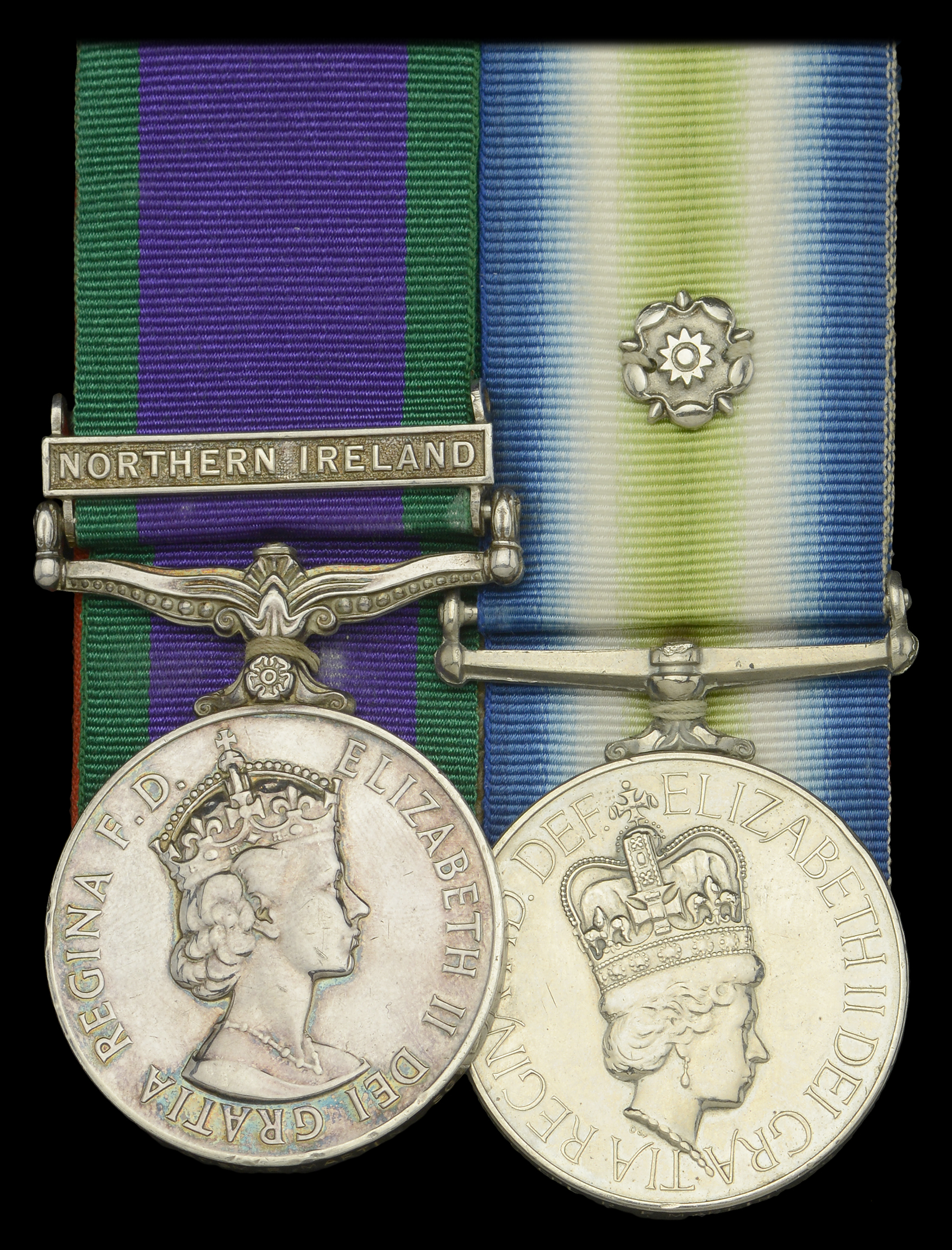349
Pair: Lance Sergeant R. F. Martin, No. 14 Platoon, 2nd Battalion Scots Guards, who took...
Bids do not include VAT, buyer’s premium or delivery.
By confirming your bid, you agree that you have read and accepted the-saleroom.com and the auctioneer's terms and conditions. Confirming your bid is a legally binding obligation to purchase and pay for the lot should your bid be successful.
Choose one of the quick bid options below:
Bids do not include VAT, buyer’s premium or delivery.
By confirming your bid, you agree that you have read and accepted the-saleroom.com and the auctioneer's terms and conditions. Confirming your bid is a legally binding obligation to purchase and pay for the lot should your bid be successful.
General Service 1962-2007, 1 clasp, Northern Ireland (24096828 Gdsm. R. Martin SG.); South Atlantic 1982, with rosette (2406828 Cpl R F Martin SG) mounted for wear, minor edge nicks, very fine (2) £1,200-£1,600
---
Robert Frederick Martin enlisted in the Scots Guards in November 1967. He advanced to Lance Sergeant, and served with No. 14 Platoon, 2nd Battalion during the Falklands. His platoon formed part of the Left Flank under Major Kiszely during the night attack on Mount Tumbledown, 13/14 June 1982. The fighting was hard going for the Left Flank, as the Argentinians had well dug-in machine guns and snipers. Eventually the British troops overwhelmed the defence positions, gaining footholds often at the point of a bayonet.
Major Kiszely was the first man into the Argentine position, personally shooting two enemy soldiers and bayoneting a third. His bayonet breaking in the process. Seeing their company commander amongst the enemy troops inspired 14 and 15 Platoons to make the final dash across open ground to get within bayoneting distance. Kiszely and six other Guardsmen suddenly found themselves standing on top of the mountain, looking down on Stanley. Martin’s own experience is recorded in The Scots Guards Magazine of 1982:
A brief mention of the Falklands Campaign is necessary to complete the picture. The Company reached an exceptional level of fitness on board the QE2 (fuelled of course by excellent cooking) and all these preparations were fully tested, several days after landing on East Falkland. When on our first night at Bluff Cove, Left Flank was told to take up a defensive position on the nearby hills, following a very unprotected approach in assault craft, the Company was exposed to some atrocious conditions. However, when the position was handed over to another Company after some 40 hours in the open, Left Flank had not suffered a single casualty due to the weather. In Bluff Cove, one must mention the sangars that were constructed in peat, and would have served well on any grouse moor in Scotland....
Later, and after the action on Mount Tumbledown, LSgt Martin’s experience is worth recording. After lowering himself into an underground enemy sangar, with only a torch, he suddenly discovered the place was already occupied, with three equally shocked Argentinians; the ensuing conversation though, does not bear repetition.’
The Battle of Mount Tumbledown resulted in 9 men killed in action and 43 wounded. The Argentines lost 30 men with a further 30 taken as Prisoners of War. For their courage displayed during the attack, soldiers of the 2nd Battalion, Scots Guards, were later recognised with the award of 1 DSO, 2 MC’s, 2 DCM’s (one posthumous), and 2 MMs. Martin was discharged, 12 November 1982.
Sold with copied research.
General Service 1962-2007, 1 clasp, Northern Ireland (24096828 Gdsm. R. Martin SG.); South Atlantic 1982, with rosette (2406828 Cpl R F Martin SG) mounted for wear, minor edge nicks, very fine (2) £1,200-£1,600
---
Robert Frederick Martin enlisted in the Scots Guards in November 1967. He advanced to Lance Sergeant, and served with No. 14 Platoon, 2nd Battalion during the Falklands. His platoon formed part of the Left Flank under Major Kiszely during the night attack on Mount Tumbledown, 13/14 June 1982. The fighting was hard going for the Left Flank, as the Argentinians had well dug-in machine guns and snipers. Eventually the British troops overwhelmed the defence positions, gaining footholds often at the point of a bayonet.
Major Kiszely was the first man into the Argentine position, personally shooting two enemy soldiers and bayoneting a third. His bayonet breaking in the process. Seeing their company commander amongst the enemy troops inspired 14 and 15 Platoons to make the final dash across open ground to get within bayoneting distance. Kiszely and six other Guardsmen suddenly found themselves standing on top of the mountain, looking down on Stanley. Martin’s own experience is recorded in The Scots Guards Magazine of 1982:
A brief mention of the Falklands Campaign is necessary to complete the picture. The Company reached an exceptional level of fitness on board the QE2 (fuelled of course by excellent cooking) and all these preparations were fully tested, several days after landing on East Falkland. When on our first night at Bluff Cove, Left Flank was told to take up a defensive position on the nearby hills, following a very unprotected approach in assault craft, the Company was exposed to some atrocious conditions. However, when the position was handed over to another Company after some 40 hours in the open, Left Flank had not suffered a single casualty due to the weather. In Bluff Cove, one must mention the sangars that were constructed in peat, and would have served well on any grouse moor in Scotland....
Later, and after the action on Mount Tumbledown, LSgt Martin’s experience is worth recording. After lowering himself into an underground enemy sangar, with only a torch, he suddenly discovered the place was already occupied, with three equally shocked Argentinians; the ensuing conversation though, does not bear repetition.’
The Battle of Mount Tumbledown resulted in 9 men killed in action and 43 wounded. The Argentines lost 30 men with a further 30 taken as Prisoners of War. For their courage displayed during the attack, soldiers of the 2nd Battalion, Scots Guards, were later recognised with the award of 1 DSO, 2 MC’s, 2 DCM’s (one posthumous), and 2 MMs. Martin was discharged, 12 November 1982.
Sold with copied research.
Orders, Decorations, Medals and Militaria
Sale Date(s)
Venue Address
General delivery information available from the auctioneer
If you are successful in purchasing lot/s being auctioned by us and opt for the item/s to be sent to you, we will use the following methods of shipment:
Within the UK
If you live within the UK, items will be despatched using Royal Mail Special Delivery. This service provides parcel tracking (via the Royal Mail website) and next weekday delivery (betwen 9am and 1pm). Items delivered within the UK are covered by our insurance company. Heavy and bulky lots will be sent by courier, in discussion with the client.
Outside of the UK
If the item/s being sent are worth under £1000 in total they are sent using Royal Mail’s Signed For International service. This ensures the item must be signed for when it is delivered.
If the item/s being sent are valued at over £1000 in total they will be sent using FedEx. This service allows next day delivery to customers in many parts of the US and parcels are fully trackable using the FedEx website.
Shipping Exceptions
Certain lots such as those containing glass or sharp implements, etc., may not be suitable for in-house shipping within or outside of the UK. Please contact Noonans with any queries.
Important Information
Auctioneer's Buyers Premium: 24% (+VAT)
There is an additional charge of 4.95% (+VAT/sales tax)










